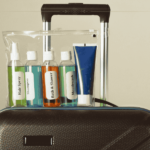Travelers face major changes to security procedures at nine key airports nationwide as next-generation scanning equipment revolutionizes the pre-flight experience.

Airport Security Revolution Takes Flight
A significant transformation is underway at airport security checkpoints across the United Kingdom as new state-of-the-art scanning technology begins operation at nine major travel hubs. The advanced Computed Tomography (CT) scanners represent the most substantial upgrade to aviation security protocols in decades, promising to streamline the passenger experience while maintaining rigorous safety standards.
The implementation of this technology marks a pivotal shift in how travelers navigate one of the most time-consuming and often frustrating aspects of air travel. Passengers departing from these equipped airports can now keep electronic devices and liquids in their hand luggage during the security screening process—a dramatic change from longstanding requirements that have defined airport security since the early 2000s.
This development comes after previous attempts to roll out the technology faced setbacks, creating confusion among travelers. However, the current deployment appears to represent a more permanent and widespread adoption of the advanced screening capabilities across the UK’s aviation network.
The End of Electronics Removal
For frequent flyers, the ritual has become second nature: approaching security, laptops and tablets must be removed from bags, placed in separate trays, and sent through scanners individually. This process, while necessary for security using older technology, has long been identified as a significant contributor to checkpoint delays and passenger frustration.
The new CT scanners fundamentally change this requirement. Using technology similar to medical CT scans, these advanced machines create detailed three-dimensional images of bag contents, allowing security personnel to examine electronics from multiple angles without requiring physical separation from luggage.
This means travelers departing from the equipped airports can now keep devices safely packed in their carry-on bags throughout the security process. From powerful laptops and tablets to smaller items like smartphones, e-readers, and cameras, all electronic devices can remain securely stowed during screening.
This change eliminates a significant pain point in the security process. The removal and repacking of electronic devices has historically created bottlenecks at security checkpoints, particularly during peak travel periods and in airports serving business travelers who often carry multiple devices. Security experts have estimated that the simple act of keeping electronics packed could reduce processing time by as much as 30% per passenger.
Liquids Stay Packed—But Size Restrictions Remain
Perhaps equally significant is the change to liquid screening procedures. Since 2006, international air travelers have lived with the familiar “3-1-1” rule: liquids limited to 3.4 ounces (100ml) containers, all fitting within a single one-quart clear plastic bag, with one bag per passenger.
The new scanning technology eliminates the requirement to remove these liquids from bags during the screening process. Passengers can now keep toiletries, medications, and other liquid items packed within their carry-on luggage rather than presenting them separately in clear plastic bags.
However, it’s crucial for travelers to understand that while the process has changed, the fundamental restriction on liquid quantities remains firmly in place. The 100ml limit for individual containers has not been lifted. This distinction is important to emphasize, as confusion around this point could lead to confiscated items and disrupted travel plans.
Security officials have indicated that the 100ml restriction continues as part of a multi-layered approach to aviation security. While the scanning technology has advanced, regulations regarding potentially dangerous substances remain conservative as the entire system evolves.
The Technology Behind the Change
The transformation in security procedures stems directly from the capabilities of Computed Tomography (CT) scanning technology. Unlike conventional X-ray scanners that produce two-dimensional images, CT scanners create detailed three-dimensional representations that can be rotated and examined from multiple angles by security personnel.
This enhanced imaging capability allows screeners to more easily identify potentially concerning items without requiring physical separation from the rest of the luggage contents. Security analysts can examine items layer by layer, identifying materials based on density and composition in ways that weren’t possible with previous technology.
The CT scanners represent a significant investment in infrastructure, with each unit costing approximately £300,000. This investment reflects the dual priorities of enhancing security capabilities while improving the passenger experience—goals that have often seemed at odds in aviation security planning.
Beyond the passenger benefits, the technology offers security advantages as well. The more detailed imaging can potentially identify threatening items that might be missed by conventional scanners, while reducing the human factors that come into play when items must be repeatedly handled and repositioned during screening.
Nine Airports Leading the Change
The new scanning technology and associated procedural changes are currently operational at nine airports across the United Kingdom. These facilities represent a cross-section of the UK’s aviation infrastructure, from major international hubs to regional airports serving specific markets:
Birmingham Airport, which serves over 12 million passengers annually as a key transport hub for the Midlands, has fully implemented the new system across its security checkpoints. As one of the UK’s busiest airports outside London, this implementation affects a significant portion of the country’s domestic and international travelers.
Bristol Airport in southwest England has similarly completed the technology transition. With its growing importance as a regional gateway and expanding route network to European destinations, Bristol’s adoption improves the travel experience for approximately 9 million annual passengers.
Edinburgh Airport, Scotland’s busiest airport and a critical connection point for international visitors to the country, now offers the streamlined security process to its more than 14 million annual passengers. As a key business and tourism gateway, the improved efficiency particularly benefits the high volume of business travelers passing through its facilities.
London Gatwick Airport, the UK’s second-busiest airport handling over 46 million passengers in typical years, represents one of the most significant implementations of the new technology. As a major international hub with hundreds of daily departures, the efficiency improvements at Gatwick will be felt by travelers throughout the global aviation network.
Leeds Bradford Airport in northern England has completed its technology upgrade, benefiting passengers traveling through this growing regional hub. Serving the Leeds-Bradford metropolitan area, the airport’s adoption of advanced screening enhances the travel experience for business and leisure travelers across Yorkshire.
London Luton Airport, which serves as a base for several low-cost carriers and handles approximately 18 million passengers annually, now offers the enhanced security process. As an airport particularly focused on efficiency due to its low-cost carrier business model, the streamlined procedures align well with its operational philosophy.
Newcastle International Airport in northeast England has implemented the new scanners across its security checkpoints. As the primary international gateway for northeast England and parts of southeastern Scotland, Newcastle’s adoption improves the travel experience for approximately 5 million annual passengers.
London Southend Airport, which has positioned itself as a convenient alternative to larger London airports, now features the advanced screening technology. Though smaller than other London-area airports, Southend’s implementation reflects the broad adoption of the new standards across diverse airport environments.
Teesside International Airport in northeast England rounds out the current list of facilities offering the enhanced security experience. As a regional airport serving the Tees Valley area, Teesside’s adoption demonstrates that the technology implementation extends beyond just the largest UK airports to include regional transport hubs.
Airport authorities emphasize that while these nine airports currently offer the new procedures, travelers should verify current protocols before departure, as operational adjustments remain possible during this transition period. The aviation authority recommends checking airport websites for the most up-to-date information specific to each facility.
The Timeline for National Implementation
While nine airports currently offer the enhanced security experience, the transition represents just the beginning of a national implementation strategy. Government authorities have established June 2025 as the target date for all UK airports to be equipped with the advanced scanning technology.
This timeline reflects the complex logistical challenges involved in upgrading security infrastructure across dozens of airports nationwide. The process involves not only equipment installation but also staff training, operational procedure development, and extensive testing to ensure systems function properly within each airport’s unique physical environment.
The phased approach allows for learning and refinement as the technology deploys across increasingly diverse airport environments. Early adopters provide valuable operational data that can inform implementations at other facilities, potentially streamlining future deployments.
For travelers, this timeline means that security procedures will vary by departure airport for approximately the next year. This inconsistency presents potential confusion, particularly for passengers who might experience different requirements at different airports during the same journey. Travel experts recommend that passengers prepare for traditional security procedures while being pleasantly surprised if their departure airport offers the enhanced experience.
The Passenger Experience: What Travelers Should Expect
For passengers departing from airports equipped with the new technology, the security experience differs noticeably from traditional procedures. Upon approaching the checkpoint, travelers receive instructions from security personnel regarding the modified process.
The most immediate difference is that electronic devices—laptops, tablets, e-readers, cameras, and other items—can remain packed in carry-on luggage. This eliminates the familiar scramble to extract electronics and place them in separate bins, followed by the equally rushed repacking process on the other side of the screening area.
Similarly, liquid items in containers of 100ml or less can remain packed within luggage rather than being presented separately in clear plastic bags. This streamlines the preparation process and reduces the risk of items being left behind at security—a common problem when multiple bins are used.
The actual screening process appears largely unchanged from the passenger perspective, with bags still passing through scanning equipment on conveyor systems. The difference lies in the technology examining the contents and the information available to security personnel reviewing the scans.
While these changes significantly improve convenience, security experts emphasize that other aspects of the security process remain unchanged. Passengers must still pass through body scanners or metal detectors, remove outerwear such as coats and jackets, and may be subject to additional screening based on random selection or security concerns.
The time savings from the new procedures varies depending on passenger volume and individual circumstances, but early data suggests security processing times could improve by 20-50% during peak periods. This efficiency gain benefits not only individual travelers but the overall aviation system by reducing congestion at key chokepoints.
Previous Attempts and Lessons Learned
The current implementation follows earlier attempts to introduce the technology that faced challenges and setbacks. In 2023, several UK airports briefly implemented similar changes before reverting to traditional procedures after just weeks of operation, creating significant confusion among travelers.
Those earlier efforts encountered operational difficulties that hindered full deployment. Technical integration challenges, staff training issues, and inconsistent application of new protocols contributed to the decision to temporarily pause the transition. The brief implementation and subsequent reversal left many passengers frustrated and uncertain about security requirements.
The current deployment appears to have addressed many of these earlier challenges through more comprehensive planning and preparation. Airport authorities report improved staff training programs, better system integration, and clearer communication protocols to ensure consistent application of the new procedures.
This more methodical approach represents an important lesson from earlier implementation attempts. Aviation security changes require careful coordination across multiple stakeholders, from government regulators and airport operators to airlines and security contractors. The current success demonstrates the importance of thorough preparation when implementing significant operational changes in complex systems.
Implications for Different Traveler Types
The security changes affect different traveler segments in various ways, with business travelers potentially seeing the most significant benefits. This group typically carries multiple electronic devices and travels frequently, making the streamlined process particularly valuable for their regular journeys.
Family travelers with children also benefit substantially from the simplified procedures. Keeping liquids packed reduces the complexity of managing young children through security while simultaneously unpacking and repacking multiple bags. Parents have long identified security checkpoints as one of the most stressful aspects of traveling with children.
Elderly travelers and those with mobility challenges find the new procedures less physically demanding, as they eliminate the need to repeatedly bend and reach into bags to remove and replace items. This reduces the physical strain of the security process for passengers who may have difficulty with such movements.
International visitors to the UK benefit from greater consistency with emerging global standards. As similar technology deploys at airports worldwide, the alignment of security procedures reduces confusion for travelers navigating different national security systems during international journeys.




